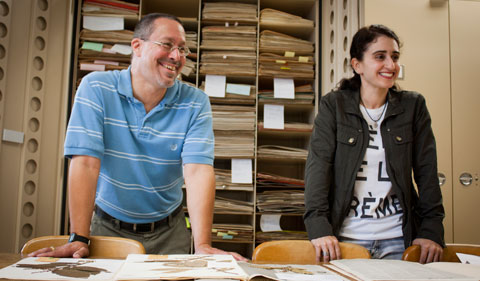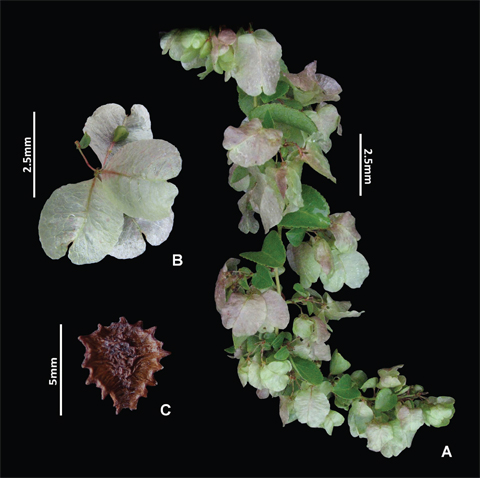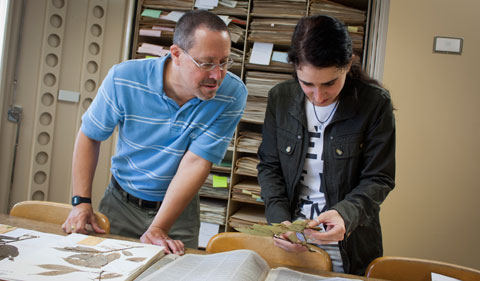
Harvey Ballard and Juliana De Paula Souza in the Floyd Bartley Herbarium
Dr. Juliana De Paula Souza of Federal University of São João del-Rei in Brazil has named a new species of Latin American violet—Anchietea ballardii—after Dr. Harvey Ballard, Associate Professor of Environmental & Plant Biology at Ohio University.
“Juliana first visited my lab, for two months in spring and summer 2008 as a doctoral student working on Brazil’s violoid violet genera,” Ballard says. “We trained her in molecular systematic approaches, and she generated a large amount of data for her dissertation research and also contributed that data and her taxonomic expertise to our collaborative Violaceae phylogeny project. The second time she came to OHIO was as a postdoctoral fellow on a grant from Science Mobility Programs. She spent a year here in Athens during June 2013 through May 2014 to study hybanthoid and other Latin American violet groups with me, with our travel to major herbaria supported by a Baker Fund grant.”
The new species, which is described as endangered, was announced in an article on “Novelties in Brazilian Anchietea A.St.-Hil. (Violaceae): A new species from inselbergs in the Atlantic rainforest and an update on the conservation status of Anchietea ferrucciae Paula-Souza & Zmarzty” published in Phytotaxa. Her co-author is José Rubens Pirani.

Anchietea ballardii. A. Habit (fruiting branch), B. 4-valved capsule bearing an immature seed, C. Seed from dried herbarium specimen. Photo: J.Paula-Souza.
Their paper is the latest in a series of taxonomic studies of the Neotropical lianescent genera of the Violaceae, which will result in a complete revision of the group in the near future.
The new species is similar to Anchietea ferrucciae, which occurs in a narrow area of Caatinga, the dry forests in the northeastern part of Brazil, with a possible disjunction in the inselbergs of the Atlantic rainforest of Espírito Santo state,” they write in the introduction.
“Inselbergs are rocky outcrops that are considered “land islands” of xeric habitats within a larger area of humid rainforest. Further analysis of herbarium samples and living specimens in the field provided strong evidence that the inselberg populations of Anchietea deserve recognition as a distinct new species, which is described here as Anchietea ballardii.”
They note that the Anchietea ballardii is similar to the Anchietea ferrucciae, “but it differs by the obovate to suborbicular fruit valves and ovate or widely elliptic to suborbicular leaves, and a more congested arrangement of leaves and flowers/fruits.”
The authors note that “since most samples of the new species were collected from sites with some degree of disturbance (mostly by wood cutting followed by grazing and agriculture), and there is a single record of the new species from a conservation unit (Área de Proteção Ambiental da Pedra do Elefante), we assign to Anchietea ballardii a conservation status of Endangered (EN B1ab, B2ab).”
Abstract: Anchietea ballardii Paula-Souza, a new species of Violaceae endemic to inselbergs in Espírito Santo state, Brazil, is described and illustrated. The new species is morphologically similar to Anchietea ferrucciaePaula-Souza & Zmarzty, endemic to the Caatinga in Bahia state, being recognized by its obovate to suborbicular fruit valves, ovate or widely elliptic to suborbicular leaves and more congested arrangement of leaves and flowers/fruits. An updated key to the species of Anchietea A.St.-Hil. is provided, and a preliminary conservation assessment using IUCN criteria are provided for both the new species and and A. ferrucciae.

Harvey Ballard and Juliana De Paula Souza examine a specimen in the Floyd Bartley Herbarium.



















Comments